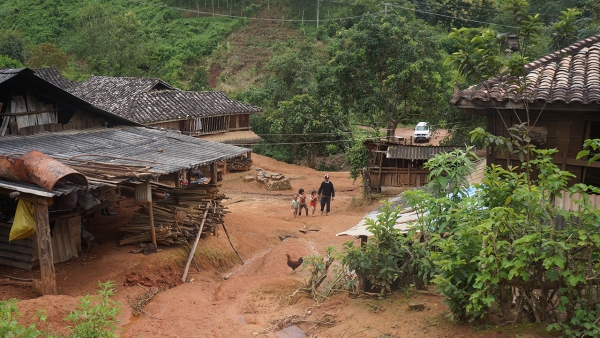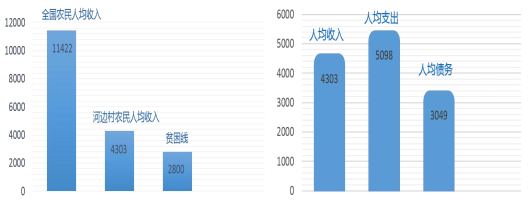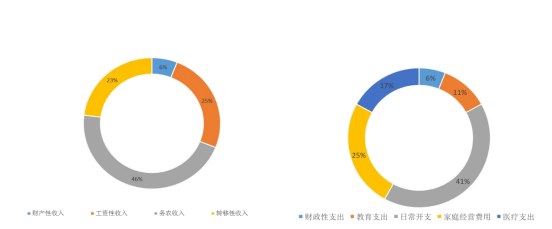Abstract
Located in a remote corner of Yunnan Province near the China-Laos border and mostly inhabited by members of the ethnic Yao minority, Hebian Villager Group ("Hebian Village") under the Mengban Villager Committee of Mengban Town in Mengla County, Xishuangbanna Dai Autonomous Prefecture, was trapped in structural poverty until recently. In 2015, China Agricultural University (CAU) professor Li Xiaoyun began conducting a comprehensive poverty reduction experiment involving infrastructure, ecotourism, agriculture, education, and capacity building with the goal of helping locals improve their living conditions, creating business opportunities, and facilitating the creation of long-term development plans in order to address the situation. Largely carried out by CAU and a non-profit organization, the innovative undertaking differs from many of the poverty alleviation programs that have been implemented in China in the past. The two institutions used their intellectual and social resources to eliminate poverty in a practical manner and liaised with locals on behalf of the government, which provided leadership in the form of financial and policy support, and residents have played an active role rather than merely functioning as passive recipients of government assistance. Although the experiment has been full of obstacles and uncertainties, Li has been happy to witness the improvements that have been occurring in the village by the day and hopes it contributes to the realization of the United Nations' Sustainable Development Goals for 2030.

A view of Hebian Village as it appeared when Prof. Li Xiaoyun first saw it in 2015 (Photo from China Agricultural University's website)
A Remote Village Trapped in Structural Poverty
Part of the Nanla River Basin tropical rainforest nature reserve near the China-Laos border, Hebian Villager Group ("Hebian Village") under the Mengban Villager Committee of Mengban Town in Mengla County, Xishuangbanna Dai Autonomous Prefecture, Yunnan Province, translates to "riverside" in English. The remote hamlet features spectacular natural scenery, generally favorable weather conditions throughout the year, and unique ethnic culture but suffered from structural poverty until recently.
The 57 households in the village are composed of 206 members, the vast majority of whom are part of an ethnic minority group known as the Yao with a population of about 2.6 million that mostly lives in the southern part of China. Local residents mostly cultivated corn, rice and sugarcane, and raised pigs and chickens for a living in addition to engaging in some foraging in the jungle before poverty alleviation projects were launched in Hebian.
The 8-km road leading to the village was bumpy and muddy, which often led to crops rotting in the fields when transportation and distribution became very difficult during the rainy season. A large percentage of Hebian's residents were illiterate; those who graduated from middle school were considered to be highly educated. Only a few were able to find long-term work in other areas due to the poor Mandarin that generally prevailed, while most people who stayed in the village lived in cramped, shabby, wooden, two-story dwellings that lacked toilets, windows and kitchens, and tended to be permeated with foul odors due to the fact that the pigs and chickens that they raised were often housed on the first floor.
Annual disposable income hovered at RMB4,303 per capita, while annual expenditures came to an average of RMB5,098, which caused per capita debt to reach RMB3,049 in 2015. The range of disposable income that Hebian’s inhabitants generated was very narrow; everyone earned little, and no one was thriving.
Residents often fell into the poverty traps that existed as a result of the low incomes, high expenditures, and high debt loads that prevailed. Many people financed the purchase of consumer goods with debt, while unavoidable expenditures associated with education, health care, and other aspects of modern welfare piled up on top of traditional expenditures.

Figure 1: Disposable income per capita in rural China as a whole (first bar) and Hebian Village (second) in 2015 and the rural absolute poverty line as defined by the central government the same year (third)
Figure 2: Per capita income (first bar), expenditure (second), and debt (third) in Hebian in 2015

Figure 3: Sources of income in Hebian in 2015
Figure 4: Hebian residents' expenditures in 2015
An Experiment with a Comprehensive Approach
In 2015, Li Xiaoyun, dean of China Agricultural University's (CAU) College of Humanities and Development Studies, proposed engaging in a comprehensive poverty reduction experiment involving undertakings such as infrastructure, ecotourism, agriculture, education, and capacity building, and stepped down from his position, hoping to help Hebian's inhabitants improve their living conditions, create business opportunities, and facilitate the creation of long-term development plans in order to address the situation.
China's government was providing funding for housing renovation in villages across the country as part of a broad push to alleviate poverty through rural infrastructure-building programs at the time – a policy Li helped advise. He thought that Hebian's fresh air, beautiful landscapes, and ethnic characteristics could make it an ideal destination for small, high-end conferences, company retreats, summer and winter student camps, and members of the middle class who want an escape from urban areas and that the village's residents could use these subsidies to update their traditional dwellings and transform them into guesthouses.
Hebian would overhaul its industries by focusing on unique, high-end, characteristic undertakings that do not compete with traditional agricultural development projects and utilize government funding devoted to infrastructure and housing in order to boost incomes. Crops such as corn, rice and sugarcane continued to be grown in order to ensure a basic supply of food and income, while characteristic agricultural products, such as organic chicken eggs, honey, a local breed of pig, grapefruit, papayas, bananas, traditional Chinese herbs, and winter vegetables, would also be produced in the local rainforest in order to enhance villagers' abilities to resist risk and diversify income streams. Not priced for the general market, the latter are intended to be sold to high-end customers via e-commerce platforms and direct purchase orders.
A children's activity center, preschool, and a childhood nutrition improvement program were launched in order to help stem the intergenerational transmission of poverty, and a farmers' cooperative and a youth entrepreneurship group were stablished in order to facilitate the development of community members' capacities, with the goal of the village eventually being able to run its own affairs.
Largely carried out by CAU and a non-profit organization registered in Mengla devoted to volunteer recruitment and fundraising known as Action Against Poverty (AAP China), the innovative undertaking differs from many of the poverty alleviation programs that have been implemented previously in China. The two institutions used their intellectual and social resources to eliminate poverty in a practical manner and liaised with locals on behalf of the government, which provided leadership in the form of financial and policy support, and residents have played an active role rather than merely functioning as passive recipients of government assistance, which is an important aspect of the experiment.
The Mengban and Mengla governments devoted a total of nearly RMB20 million of funding from various programs to road construction, housing renovation, and support of business creation in the village. More than RMB3 million was also raised by AAP China over the course of three years after Li Xiaoyun established it in early 2015, which was used for various other endeavors.

A view of a revamped Hebian Village (Photo provided by Li Xiaoyun.)
A New Look and a New Future
The first step of nurturing tourism in Hebian consisted of updating and revamping the housing in the village. The existing distinctive wooden Yao residences were renovated, equipped with modern facilities, and outfitted with at least one guest room each, which makes it possible for visitors to maintain their privacy while experiencing authentic ethnic culture in a leisurely manner.
Li Xiaoyun arranged for a daring resident's home to be remodeled in order to demonstrate what he had in mind. Their peers reacted favorably and quickly signed up to get their own residences updated. Homeowners renovated their dwellings with construction workers from other areas and learned new skills in the process, and the work was mostly done by the end of 2017.
Supporting facilities including conference rooms, home-based restaurants, convenience stores, and even a bar duly followed, and diverse leisure products that incorporate Yao customs and culture were developed. Hebian's visitors tend to be impressed by the sound, tidy facilities that exist in its borders.
"The people who run the guesthouses and home-based restaurants in the village didn't even know how to make the beds or set the tables properly when they first began,” Mengla Bureau of Human Resources and Social Security official Li Tianhong noted in 2020. "So we held special hospitality management training courses for them."
Hebian-based accountant Deng Guolin stated that the village's inhabitants now provide better services and noted that visitors have been coming from other provinces and even other parts of the world.
A standard room currently runs for around RMB500 per day, which is the same as a five-star hotel room rate in central Xishuangbanna, and the organic cuisine in the village is a little pricier than most of the offerings in central Mengban Town. Most visitors want to experience Hebian's unique Yao culture and are willing to pay, however.
The village's households brought in an average of RMB8,800 of income from their guestrooms in 2019 according to data provided by Li Xiaoyun's team, while the families that run restaurants in their homes bring in RMB5,000 to RMB22,000 of income per year from the endeavor, or an average of RMB14,000. A member of one of these families named Li Jin mentioned that the crop farming that people engaged in in the past mostly only covered their basic needs and it was very difficult to bring in around RMB10,000 of income in a year.
Nearly every family in Hebian continues to raise chickens as well. One of the larger chicken farmers in the village, Huang Yuanzhou keeps at least 30 to 40 chickens at all times but was not able to generate much income with them until several years ago. The Hebian youth entrepreneurship group launched a store devoted to organic products produced in local tropical rain forests on a microservices-based e-commerce platform under the guidance of Liao Lan, a professor who works at CAU. Free-rang eggs are sold for RMB10 each to customers in cities like Beijing, Shanghai and Guangzhou, while ordinary ones usually sell at RMB7 to RMB11.2 per kg, or around RMB0.45 to RMB0.7 each. More than 5,000 eggs had been sold from the store as of July 2017.
Some of the people who were born in Hebian used to work as migrant laborers in the past, while the village's children tended to run around barefoot, not speak Mandarin Chinese very well, and hide when they encountered strangers. A lot has changed in recent years, however. Hebian natives are able to earn stable incomes locally and have improved their lifestyles, while local youth have developed good health and hygiene habits, speak Mandarin more fluently, and greet visitors warmly.
Established in 2019, Hebian's farmers' cooperative is composed of young people who have experience working in other areas and has gradually been taking over responsibilities that AAP China was in charge of, while the non-profit continues to provide assistance with marketing. Hospitality companies have not been invited to manage guesthouses due to concerns that this would lead to profits flowing out of the village.
Although the experiment has been full of obstacles and uncertainties, Li Xiaoyun has been happy to witness the improvements that have been occurring in the village by the day and hopes it contributes to the realization of the United Nations' Sustainable Development Goals for 2030.
References (Names and links):
From forgotten village to desirable destination
https://stories.cgtneurope.tv/hubs/innovation-action-change/action-on-poverty/index.html
Mengla poverty-stricken Yao village turned into tour destination
http://english.yunnan.cn/html/2020/latestnews_0603/20182.html
Villagers' living conditions upgraded in Chinas Yunnan
https://english.www.gov.cn/news/photos/201911/18/content_WS5dd2409fc6d0bcf8c4c1753c.html

For more information, please contact WFP China COE (wfpcn.coe@wfp.org)
Category
Comprehensive Experiment Eliminates Structural Poverty in Ethnic Yao Village
Contributor
Comprehensive Experiment Eliminates Structural Poverty in Ethnic Yao Village
Country
Case Study

